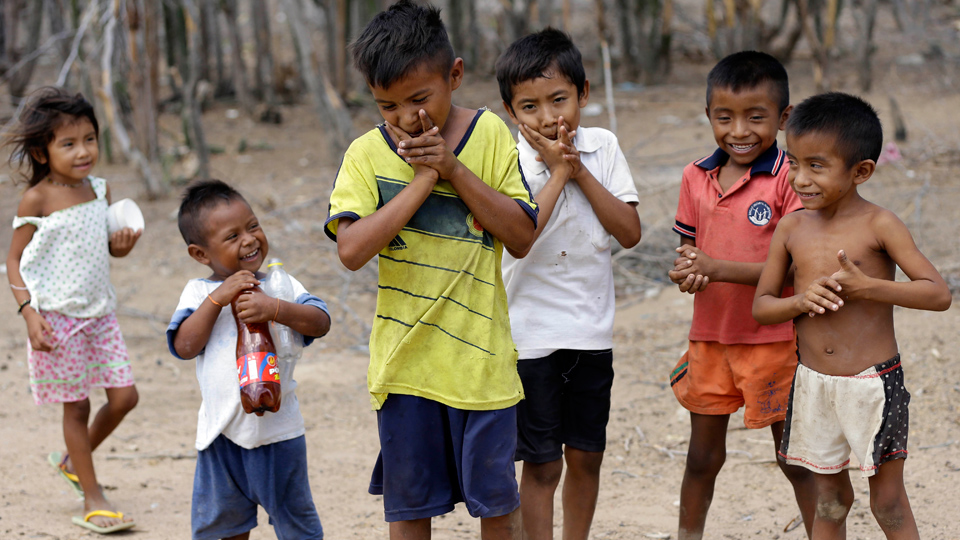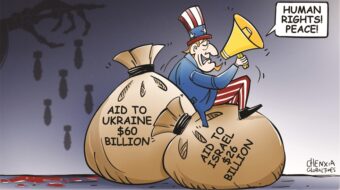
The Wayúu indigenous people make up nearly half the population of La Guajira department in Colombia’s extreme northeast. They won’t be finding much peace from the agreement Colombia’s government and FARC insurgents signed in late 2016 to end their war. The government’s chief negotiator, Humberto de la Calle, said as much in 2012 when negotiations were beginning.
The former Colombian vice-president warned that, “We are not going to negotiate the development model of Colombia, nor the legal framework which supports private property, nor the current foreign investment model in the country, nor the military doctrine of the government.”
El Cerrejón coal mine
The owners of El Cerrejón coal mine, nemesis of the Wayúu, must have been satisfied. They include: BHP Billiton (Australia), which, operating in 100 locations in 25 countries, extracts iron ore, oil, coal, and diamonds; Anglo-American (South Africa) which mines coal, iron ore, and copper in South Africa, Australia, and the Western Hemisphere; and Glencore (Switzerland), the tenth largest corporation in the world, producing 90 commodities. Profits of the three in 2016 were: $3.2 billion (July through December), $1.59 billion, and $3.67 billion, respectively.
The Colombian government’s version of peace suits the U.S. government. That was the message of the Obama administration’s “Peace Colombia” plan, announced in February 2016. Military and police assistance to Colombia would continue, and even exceed recent levels. Funds for social and humanitarian purposes were reduced.
The stage was thus set for humanitarian disaster. In 2012, 87.7 percent of jobs in Guajira were in the informal sector, and 60 percent of workers received less than the legal minimum wage. Unemployment was 47 percent, and more than half the population lived in poverty; 25 percent, in extreme poverty.
Wayúu vulnerability
Wayúu vulnerability contrasts with the immensity of El Cerrejón. It’s the world’s largest open pit coal mine, exporting 32 million tons of coal annually. The company owns a 93–mile long railway and a deep-water seaport.
Despite an arid climate, in the past the Wayúu had been able to feed themselves. Water and land were available. Then mining and oil extraction expanded and farmers lost land. London activist Richard Solly reports that in 1960, “104,963 hectares of the department [were] suitable for agriculture; but in 2001 only 30,752 hectares were under cultivation and in 2008 much less.”
The coal mine has dominated the region since the 1980s. Cerrejón bulldozers began razing Wayúu villages in 2001. Some 30,000 acres of forest have been ravaged. Steps were taken to supply the mine with water, essential to its operations.
Beginning in 2010, the Cerrejón owners put dams across the Ranchería River and a couple of tributaries. River water now flows to the mine, 17 million liters every day. Since then – and there’s been drought – twelve rivers have disappeared, or almost so. Farm animals died because of no water. Irrigation of crops came to a halt. Now, individual Wayúu people living nearby can find, on the average, only 0.7 liters each day of untreated water to drink.
A report from 2016 says, “around 27 percent of children under five are suffering from malnutrition,” Another report from the same year states that, “more than 4770 children of this indigenous community have died over eight years due to malnourishment and a lack of drinking water.” In 2016, 36 mothers died of malnutrition.
Actual deaths may exceed these numbers inasmuch as official record keepers are unaware of the deaths of many Wayúu infants. The Colombian Pediatric Society pointed out that, “an indigenous child [in La Guajira] has a 24 times greater risk of dying than children elsewhere in the country.”
In Bogota, an observer claims, “they have no idea of La Guajira, there’s laxity in understanding it, studying it, respecting it.” A socially-conscious physician writes of “state abandonment, violent stealing of resources, and institutional and political crisis.”
Tax income and royalties from coal mining aren’t enough to bankroll social spending in La Guajira. Formerly, 85 percent of royalties from mineral extraction stayed in the local area; now “only 9.3 percent of the royalties come to the producing department.” Cerrejón benefits from a concession of no taxation until 2034. Royalties paid by Cerrejón barely exceed the value of government subsidies for the company.
Corrupt officials waylay money
Furthermore, corrupt officials waylay money the national government sends to La Guajira to pay for schooling, health care, water, and food. El Cerrejón allegedly bribes officials. Two departmental governors have gone to prison recently, one for buying votes, the other for murder.
The Inter-American Commission on Human Rights has previously insisted on “precautionary measures;” it made recommendations in late 2015 for dealing with malnutrition affecting babies and children and a year later did likewise on behalf of pregnant women and lactating mothers.
The national government recently announced it would be managing “health, education, and drinkable water resources” in La Guajira for three years, although President Juan Manuel Santos insists there’s no emergency. Colombia’s Constitutional Court sent inspectors to La Guajira. But they avoided southern regions of the department where suffering is extreme. The Council of State recently did stop the diversion of one tributary of the Ranchería River.
A powerful company is laying waste to the very weak, with state collusion. The process is hardly new, though; rapacious individuals and commercial entities have long set forth from centers of wealth and power to plunder distant regions. Capitalist imperatives dominate, wealth and power are concentrated, and marginalized peoples don’t matter. These are the markers of imperialism.
Those in charge in Colombia evidently support El Cerrejón’s successful pursuit of imperialist goals. They and the Cerrejón owners tolerate Wayúu suffering. Civil war in Colombia may be ending, but war against the Wayúu – and presumably other rural Colombians – is not.
Lastly, to suppose a creative response from the U.S. government to suffering and human rights violations in Colombia would be wishful thinking. The U.S. government supported Colombia in its internal war for decades, and there’s no sign of changed priorities.
The United States, Colombia’s partner, is the self-appointed protector and protagonist of the prevailing world economic order. The two are united in the imperialist project by which, generally, high-rollers thrive and bystanders suffer.












Comments